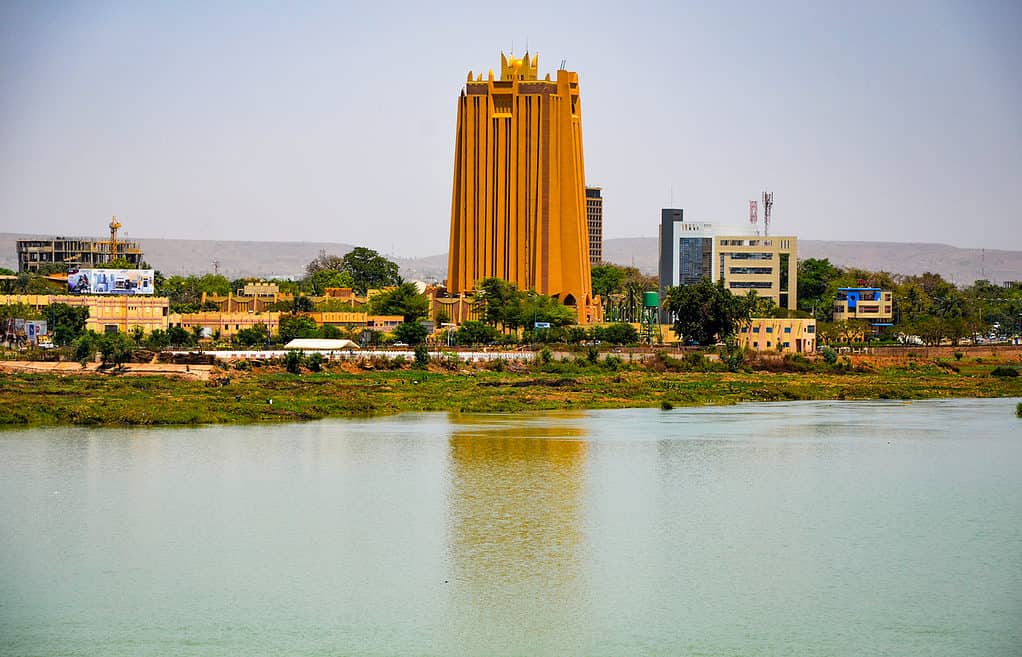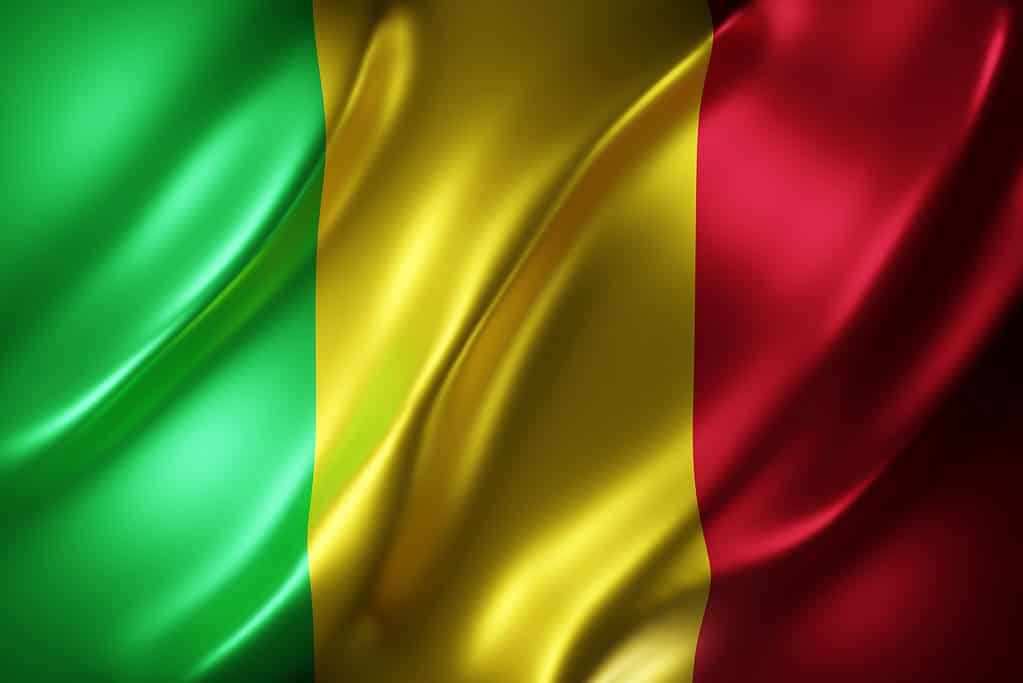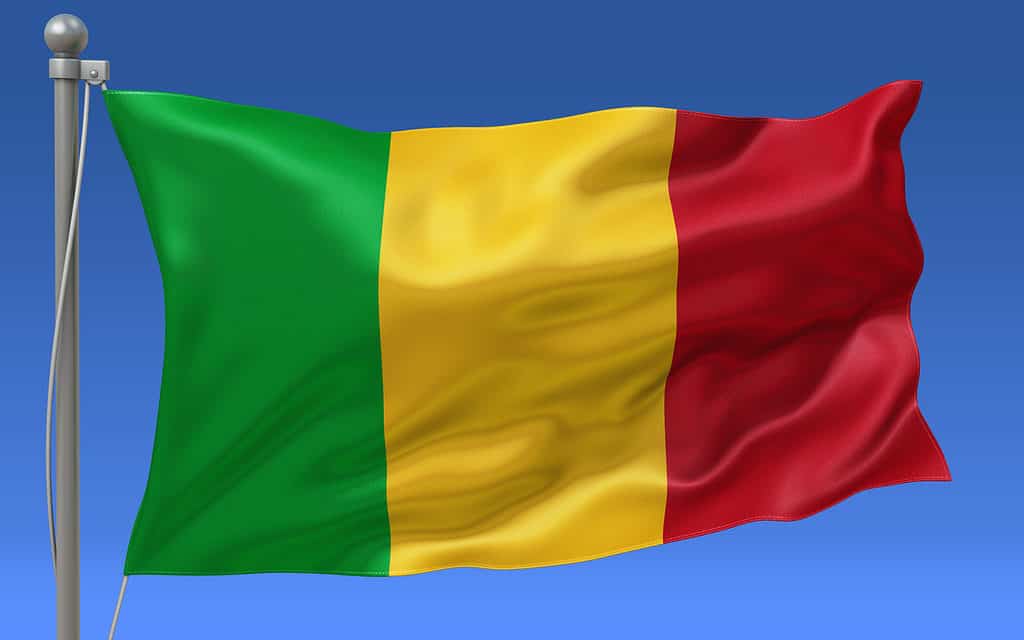Mali, officially known as the Republic of Mali, is a landlocked country in West Africa. It is bordered on the north by Algeria, on the east by Niger, on the south by Burkina Faso and Cote d’Ivoire, on the southwest by Guinea, and on the west by Senegal and Mauritania.
Mali encompasses three natural zones: the southern cultivated Sudanese zone, the central semi-desert Sahelian zone, and the northern desert Saharan zone. The Niger River is the primary source of water as it arcs northeast through Mali from Guinea to create a large and fertile inland delta before turning south and eventually emptying into the Gulf of Guinea. Mali’s terrain is primarily savanna in the south and flat to rolling plains and high plateau in the north. There are also rugged hills in the northeast, with elevations as high as 1,000 meters.
Mali’s flag consists of Pan-African colors, but that’s not the only information worth knowing about the flag. Discover the history, meaning, and symbolism of the flag below!
Founding of Mali

The capital city of Mali is Bamako.
©iStock.com/Aliou Hasseye
The earliest mention of Mali dates back to the Mali Empire (1240-1645) of West Africa and was founded by Sundiata Keita (r. 1230-1255) following his victory over the kingdom of Sosso.
Present-day Mali, also known as The Republic of Mali, was founded on September 22, 1960, after a congress of the US–RDA proclaimed the country independent. Initially, Mali was a part of French West Africa. For most of the 20th Century, Mali’s territory was declared French Sudan and headed by either a governor or a lieutenant governor. The borders were constantly modified as the French looked to extend their rule up the northern border in the Sahara Desert. In 1904, the Kayes-Bamako portion of the Ocean-Niger railroad, linking coastal Dakar with the Niger River, was completed, and Bamako became French Sudan’s capital.
During World War I and II, the French recruited and drafted Bambara soldiers from French Sudan. After both wars, the Bambara veterans achieved considerable standing within the colonial administration and gained the respect of the local population. In 1946, a territorial assembly was established, and the first political parties were formed. The Sudanese Union–African Democratic Party (Union Soudanaise–Rassemblement Démocratique Africain; US–RDA), under the leadership of its Marxist leader, Modibo Keita, ADP, became the dominant party in French Sudan.
In October 1958, the territory became known as the Sudanese Republic, and on November 24, 1958, it became an autonomous state within the French Community. In January 1959, Senegal and the Sudanese Republic joined forces to form the Mali Federation under the presidency of Keita. However, in August 1960, the federation broke up over major policy differences between the two countries. Shortly after Senegal’s withdrawal from the federation, the Sudanese Republic declared itself the independent Republic of Mali.
Characteristics of Mali

Mali is predominantly a Muslim country.
©iStock.com/Aliou Hasseye
Mali is the eighth-largest country in Africa, with an area of over 480,000 square miles. Mali’s population is approximately 21.9 million. The population is predominantly rural, with more than 5% of Malians operating as nomads. Over 90% of the population live in the southern part of Mali, as most parts of the north are semi-desert or desert. The greatest percentage of these residents—over 2 million Malians—are settled in the capital, Bamako. The population consists of diverse sub-Saharan ethnic groups that share similar historical, cultural, and religious traditions. The Bambara, Soninké, Khassonké, and Malinké make up 50% of Mali’s population. The other significant groups include the Fula, Voltaic, Songhai, Tuareg, and Moor.
While there are more than 40 African languages spoken by the various ethnic groups of Mali, the country’s official language is French, and the lingua franca is Bambara. Bambara is spoken by about 80 percent of Mali’s population.
Mali is predominantly a Muslim country. An estimated 90% of Malians are Muslim, approximately 5% are Christians, and about 5% practice African Traditional Religion.
History and Symbolism of the Flag of Mali

The green color on Mali’s flag signifies nature, fertility, and hope.
©iStock.com/Enrique Ramos Lopez
On April 4, 1959, the country’s first and original flag was adopted when Mali became a part of the Mali Federation. The flag consisted of three vertical colors: green, yellow, and red, with the Kanaga, a black stick figure that raised its arm towards the sky.
However, after a fortunate turn of events, including the federation’s complete independence on June 20, 1960, the inevitable secession of Senegal from the federation that took effect on August 20, 1960, and Mali’s Independence from France on September 22, 1960, Mali’s flag was redesigned. The new flag was adopted on March 1, 1961. It comprised the same vertical tricolor of green, yellow, and red, with the exception of the black Kanaga opposed by Muslim fundamentalists within the country.
The green color on the flag signifies nature, fertility, and hope. The yellow represents the country’s mineral resources, wealth, and purity, while the red is a reminder of the blood that was spilled in the fight to gain independence from French rule.
Besides the Mali Federation flag with the Kanaga, Mali adopted different flags before its independence. The first dates back to c. 1324 in the times of the Mali Empire. A possible historical flag consisting of a yellow rectangle centered on a red field was adopted. Also, from 1880 to 1958, while still named French Sudan, the French tricolor was adopted as the official flag of the colonial territory. Between 1958 and 1959, a new flag was adopted as French Sudan gained autonomy within the French Community. This flag consisted of the French tricolor with a black Kanaga centered on the white band. Then came the Mali Federation with the Pan African tricolor and the final flag design without the Kanaga adopted after Mali’s last lap to independence was completed.
How Did Colonization Affect the Flag of Mali?

The Pan-African colors on Mali’s flag are similar to that of Senegal and Guinea.
©iStock.com/Nabil Kamara
The design of the Mali flag was influenced by the vertical design of their French colonialists. The Pan-African colors on the flag are similar to that of Senegal and Guinea. The colors are the colors of the African Democratic Party (ADP), a political party that pioneered the country’s struggle for independence.
Up Next:
- Animals in Mali
- Different Examples of Flags With Diamonds
- The Flag of Benin: History, Meaning, and Symbolism
- The Flag of Georgia: History, Meaning, and Symbolism
The photo featured at the top of this post is © iStock.com/checha
Thank you for reading! Have some feedback for us? Contact the AZ Animals editorial team.






